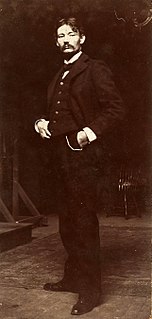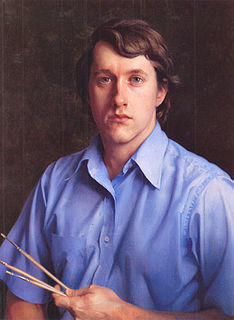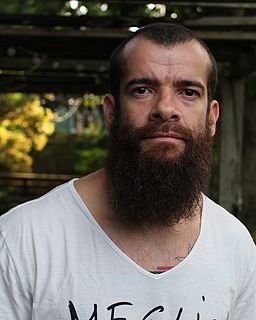
John Singer Sargent was an American expatriate artist, considered the "leading portrait painter of his generation" for his evocations of Edwardian-era luxury. He created roughly 900 oil paintings and more than 2,000 watercolors, as well as countless sketches and charcoal drawings. His oeuvre documents worldwide travel, from Venice to the Tyrol, Corfu, Spain, the Middle East, Montana, Maine, and Florida.

Visual art of the United States or American art is visual art made in the United States or by U.S. artists. Before colonization there were many flourishing traditions of Native American art, and where the Spanish colonized Spanish Colonial architecture and the accompanying styles in other media were quickly in place. Early colonial art on the East Coast initially relied on artists from Europe, with John White the earliest example. In the late 18th and early 19th centuries, artists primarily painted portraits, and some landscapes in a style based mainly on English painting. Furniture-makers imitating English styles and similar craftsmen were also established in the major cities, but in the English colonies, locally made pottery remained resolutely utilitarian until the 19th century, with fancy products imported.

Michael Peter Ancher was a Danish realist artist, and widely known for his paintings of fishermen, the lakes, and other scenes from the Danish fishing community in Skagen.

Robert Henri was an American painter and teacher.

Philip Guston, was a Canadian American painter, printmaker, muralist and draftsman. Early in his five decade career, muralist David Siquieros described him as one of "the most promising painters in either the US or Mexico," in reference to his antifascist fresco The Struggle Against Terror, which "includes the hooded figures that became a lifelong symbol of bigotry for the artist." "Guston worked in a number of artistic modes, from Renaissance-inspired figuration to formally accomplished abstraction," and is now regarded one of the "most important, powerful, and influential American painters of the last 100 years." He also frequently depicted racism, antisemitism, fascism and American identity, as well as, especially in his later most cartoonish and mocking work, the banality of evil. In 2013, Guston's painting To Fellini set an auction record at Christie's when it sold for $25.8 million.

Robert Hale Ives Gammell was an American artist best known for his sequence of paintings based on Francis Thompson's poem "The Hound of Heaven". Gammell painted symbolic images that reflected his study of literature, mythology, psychology, and religion.

Richard Whitney, is an American painter, author and educator. Town & Country magazine has named him one of the top dozen portrait painters in America. Fine Art Connoisseur has called him one of "the giants of the field" of figurative painting. Whitney's portraits and landscapes hang in over 800 public and private fine art collections worldwide. They include the Anchorage Museum of Art and History; the Anderson House Museum; the Newark Museum; the Pentagon; Harvard, Yale, and Stanford universities; and the Catholic University of Portugal. He has won over 40 regional and national awards as well as three grants from the Elizabeth Greenshields Foundation of Montreal. Whitney was awarded an Honorary Doctor of Fine Arts from the University of New Hampshire in 2015.
Dan Christensen, was an American abstract painter He is best known for paintings that relate to Lyrical Abstraction, Color field painting, and Abstract expressionism.

Philip Howard Francis Dixon Evergood was an American painter, etcher, lithographer, sculptor, illustrator and writer. He was particularly active during the Depression and World War II era.

Classical Realism is an artistic movement in the late-20th and early 21st century in which drawing and painting place a high value upon skill and beauty, combining elements of 19th-century neoclassicism and realism.

Theodore Nikolai Lukits was a Romanian American portrait and landscape painter. His initial fame came from his portraits of glamorous actresses of the silent film era, but since his death, his Asian-inspired works, figures drawn from Hispanic California and pastel landscapes have received greater attention.

Jacob Collins is an American realist painter working in New York City. He is a leading figure of the contemporary classical art revival.

The Boston School was a group of Boston-based painters active in the first three decades of the twentieth century. Often classified as American Impressionists, they had their own regional style, combining the painterliness of Impressionism with a more conservative approach to figure painting and a marked respect for the traditions of Western art history. Their preferred subject matter was genteel: portraits, picturesque landscapes, and young women posing in well-appointed interiors. Major influences included John Singer Sargent, Claude Monet, and Jan Vermeer. Key figures in the Boston School were Edmund C. Tarbell, Frank Weston Benson, and William McGregor Paxton, all of whom trained in Paris at the Académie Julian and later taught at the School of the Museum of Fine Arts. Their influence can still be seen in the work of some contemporary Boston-area artists.

John Nelson Shanks was an American artist and painter. His best known works include his portrait of Diana, Princess of Wales, first shown at Hirschl & Adler Gallery in New York City, April 24 to June 28, 1996 and the portrait of president Bill Clinton for the National Portrait Gallery.
Peter Seitz Adams is an American artist. His body of work focuses on landscapes and seascapes created en plein air in oil or pastel as well as enigmatic figure and still-life paintings. He is noted for his colorful, high-key palette and broad brushwork. Adams has held numerous solo and group exhibitions in galleries and museums, including throughout California, the Western United States, and on the East Coast in Philadelphia, Vermont, and New York. Adams is the longest serving President of the California Art Club and has served on its board of directors in Pasadena, California from 1993 to 2018. He is also a writer on subjects relating to historic artists for the California Art Club Newsletter, as well as for a number of the organization's exhibition catalogs.
Boston Expressionism is an arts movement marked by emotional directness, dark humor, social and spiritual themes, and a tendency toward figuration strong enough that Boston Figurative Expressionism is sometimes used as an alternate term to distinguish it from abstract expressionism, with which it overlapped.

Cesar Santos is a contemporary Cuban-American artist and portrait painter. He is better known for his body of work "Syncretism", a term he uses to describe paintings where he presents two or more art tendencies in aesthetic balance. He has completed numerous commissions and his work is held in private as well as public collections around the world.
Contemporary-Traditional Art refers to an art produced at the present period of time that reflects the current culture by utilizing classical techniques in drawing, painting, and sculpting. Practicing artists are mainly concerned with the preservation of time-honored skills in creating works of figurative and representational forms of fine art as a means to express human emotions and experiences. Subjects are based on the aesthetics of balancing external reality with the intuitive, internal conscience driven by emotion, philosophical thought, or the spirit. The term is used broadly to encompass all styles and practices of representational art, such as Classicism, Impressionism, Realism, and Plein Air painting. Technical skills are founded in the teachings of the Renaissance, Academic Art, and American Impressionism.
Atelier Lack was a studio school of drawing and painting established in 1969 by Minnesota artist Richard F. Lack. It was incorporated as a non-profit corporation in 1971. Richard Lack had studied with Boston artist, R. H. Ives Gammell, in the 1950s. In 1967 Lack had written "On the Training of Painters," an examination of the training of painters throughout the history of Western art, and his judgment about the superiority of the atelier, or studio system. The first years of the school were helped by three grants from The Elizabeth T. Greenshields Memorial Foundation in Montreal, Canada, “to help initiate an atelier for the purpose of training young students in the traditional craft of painting...”
Prof. Zdeněk Beran's studio of classical painting techniques at the Academy of Fine Arts in Prague (1990-2012) became a phenomenon in its own right thanks to the successful domestic and international careers of most of its graduates. Two years after graduating in 2007, Hynek Martinec was awarded the BP Portrait Award for Young Artists in the UK, and a year later he received The Changing Faces award by the Royal Society of Portrait Painters. He was followed by other students of Zdeněk Beran - Michal Ožibko (2010) and Jan Mikulka won the BP Portrait Award. In 2013, Jan Mikulka was also the first painter to receive an award for a self-portrait. Zdeněk Beran is a proof that the success of art schools depends on the fame of the personality of the artist-teacher and his real ability to provoke a creative atmosphere.




















